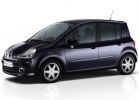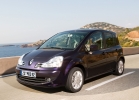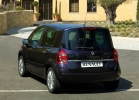Test drive by Renault Modus since 2008 minivan
Comparative test from picky Germans: the new Honda Jazz against Renault Modus
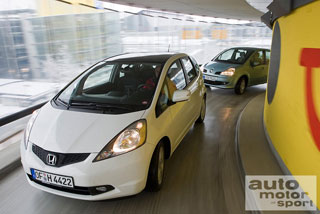 Small cars have always been successful. In the hunt for places in the city parking, there are no equal to them, but Honda Jazz and Renault Modus want to achieve even more success in the role of a smart and modern first four -wheeled friend of a person. Further, we will talk about comparing 100-horsepower versions of these models.
Small cars have always been successful. In the hunt for places in the city parking, there are no equal to them, but Honda Jazz and Renault Modus want to achieve even more success in the role of a smart and modern first four -wheeled friend of a person. Further, we will talk about comparing 100-horsepower versions of these models. When did the small car cease to be considered small? Already in 1959, when Mini with a transverse engine location and front-wheel drive presented the concept of modern compact cars and showed that a small car can be as reliable as the big one? Or in 1983, when the Peugeot 205 proved that despite compact dimensions, it can provide the same level of comfort as premium cars?
Or in 2004, when Renault Modus, when passing the crash test, Euro NCAP, was so significant about the wall that became the first supercompact car to receive five stars? Or maybe in 2008, when Honda has improved the efficiency of using the space in the JAZZ model and, along with the multifunctionality of the hatchback, gave it to such passenger capacity, which could destroy the limits of the capabilities of the middle-class city car? This is the merit of a single -volume design of Honda Jazz.
And although such a design causes a deterioration in the front review, at the same time it allows us to optimally use space. From JAZZ Square to 6.61 square meters. m to a share of the motor compartment accounts for only a small part. The placement of other components is carefully thought out by the fuel tank, for example, shelter under the front seat.
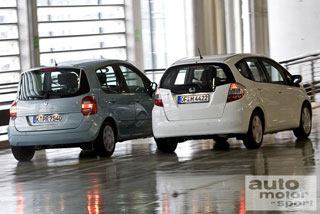 Thanks to this decision in a family car, there is enough free space, despite a very mediocre space above the head for adult passengers. In addition, the luggage compartment volume is 399 liters, which is comparable to the indicators of cars of significantly larger sizes of Seat Altea or Volvo V50, they can hardly offer more. Like the first generation of Jazz, the new model also impeccably demonstrates its skill in the origami of the rear seat. With the help of two levers, the seats fold, creating a free even platform 1.72 m long.
Thanks to this decision in a family car, there is enough free space, despite a very mediocre space above the head for adult passengers. In addition, the luggage compartment volume is 399 liters, which is comparable to the indicators of cars of significantly larger sizes of Seat Altea or Volvo V50, they can hardly offer more. Like the first generation of Jazz, the new model also impeccably demonstrates its skill in the origami of the rear seat. With the help of two levers, the seats fold, creating a free even platform 1.72 m long. The rear seats demonstrate the wonders of acrobatics
The seats can take shape in a different way, like chairs in the cinema, that is, the lower part rises to the back; Then the released space from the rear door to the front seats is enough even for two mountain bicycles with the front wheels removed. The rear seats Renault, starting with the R16 configuration, are also famous for their talent in the field of acrobatics. So, in Modus, the seat can be pushed by 17 cm and turn it into more convenient chairs for two passengers. The backs are leaned independently of each other, and the folded rear row is neatly placed behind the front seats. Then in Modus a flat luggage surface is formed, which, of course, is inferior to Jazz in area (however, like standard luggage compartments). But due to the larger opening of the rear door in Modus, loading luggage is somewhat more convenient.
Problems Modus trifles
Modus passengers, located behind, feel less comfortable due to hard seats. Softer front chairs are more convenient for long -term trips, during which you can study the electronics of the middle console and the difficulties of control of Modus, which, most likely, will cause irritation. Jazz cockpit, on the contrary, is traditional, there is no flicker and blinking on the panel, and despite the abundance of buttons, it is easier to control this car.
At the same time, the standard equipment of the most expensive version of Exclusive includes much more than just a set of necessary equipment: here you will find both climate control and light sensor. But buying Modus, you will have to pay additionally even for the course stability system. The stinginess of the small -leafers remained in the past. And 100 hp Now perceived differently than before. For middle -class cars, this indicator was considered a sound barrier, overcoming which they fell into the establishment, and for small -leafers by the border of the territory of hot hatchbacks.
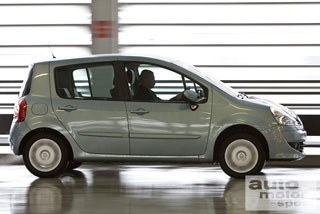
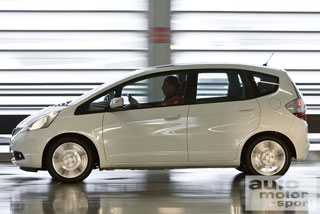
But Jazz and Modus are still not hot hatchbacks, they are not nimble enough. Their hundred horses provide appropriate dynamics. The 1.2-liter Renault engine is given by a turbocharger with a pressure of 0.7 bar. Moreover, it is not always possible to hide that the weak motor does not have enough working volume: for example, when moving along an autobahn, when, after a plot marked by the sign, the car needs some time so that the necessary boost pressure for rapid acceleration from low speeds appears.
But this is an insignificant problem in comparison with the asthmatic attempts of the Honda atmospheric engine to gain strength. And 190 additional cubes of volume are not enough for him to resist the fight against turbocharged Renault after the termination of acceleration, you need to constantly maintain the number of revolutions of the 1.4-liter Jazz engine in the region of 4,000 rpm. After the speedometer arrow will pass in 120 km/h, acceleration practically disappears. To continue acceleration, you will need to switch to a lower gear.
Fuel consumption is high
So, a quiet click, with one transmission below, the motor, making a piercing sound, makes Jazz run more fun. But the constant riding at high speeds negatively affects the fuel consumption: 7.7 liters per 100 km are too many for this class of cars. Modus consumes even more greedy at high speeds by 0.6 liters more, but it is permissible to him, because it has enough moment to go at low speeds and for a long time to do without switching gears of a stretched 5-speed box.
In addition, due to this, Modus makes no less noise than Jazz. In addition, comfort does not belong to the strengths of Jazz. He would be glad to look sporty, but with a roar passes through the stormwood, jumps at the joints of the road and suffers Fiasco on any irregularities of the coating due to too hard the suspension.
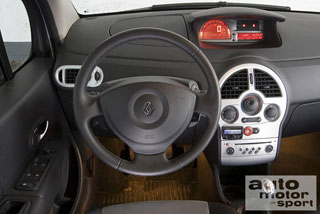
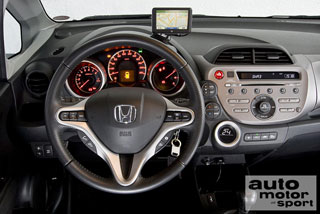
In this, it is noticeably different from Modus, because the Frenchman overcomes even deep potholes with dignity, without slowing down and without losing the quality of control. And even its passive and inaccurate steering wheel is less annoyed than the Jazz steering wheel, in which it twitches in a neutral position and turns the minimum movements of the steering wheel into too large deviations of the car from the previous course. So in the end, Jazz does not save its entire spaciousness of the salon and multifunctionality. He wished to become a large small car, but the matured Modus and so belongs to the class of cars that are already small at the same.
The results of the test
Renault Modus 1.2 TCE scored 454 points out of 650. Despite the fact that this car is not so roomy, it is much more comfortable on the road than in Jazz. In addition, Modus boasts an engine with a turbine, which, along with a living temperament, has a slightly increased appetite. Since Modus has no significant drawbacks, he defeats Honda's hatchback brand.
Honda Jazz 1.4 received 450 points out of 650. At the same time, two circumstances became the decisive criteria: a sleepy motor and poor depreciation. These shortcomings cannot be compensated by either a spacious salon, or multifunctionality, or even low fuel consumption. But still, the JAZZ equipment spectrum, which includes ESP in the basic configuration, deserves praise.
general information
Honda Renault brand
Model JAZZ 1.4 I-VTEC Modus 1.2 16V TCE
Release date 11/2008 07/2007
Basic cost 18 850 euros 15 200 euros
Engine
Type in order
Number of cylinders 4 4
Volume 1 339 cubic meters. cm 1,149 cubic meters. cm
Power 100 hp (73 kW) at 6,000 rpm 100 hp (74 kW) at 5,500 rpm
Torque 127 nm at 4,800 rpm 145 nm at 3,000 rpm
Dimensions/weight
Full length 3 900 mm 3 874 mm
Full width 1 695 mm 1 709 mm
Full height 1 525 mm 1 589 mm
Wheel base 2 495 mm 2 482 mm
Weight 1 106 kg 1 173 kg
Acceleration
0-80 km/h 7.9 from 7.2 s
0-100 km/h 11.6 s 11.1 s
0-120 km/h 17.0 s 15.8 s
0-130 km/h 20.3 from 19.6 s
0-160 km/h - 37.1 s
Declared 0-100 km/h 11.4 from 11.2 s
Maximum speed 182 km/h 180 km/h/hour
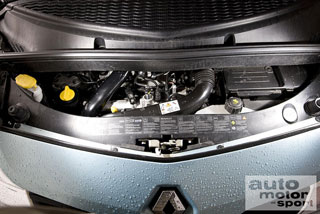
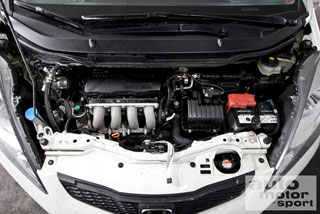
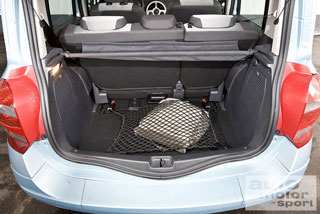
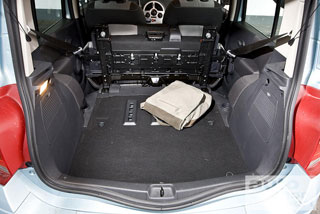
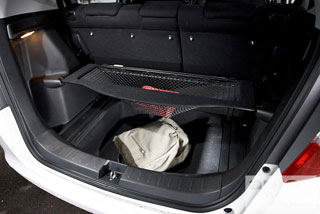
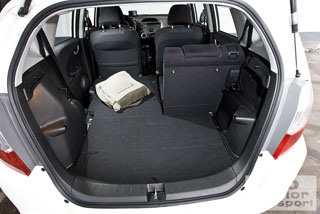
A source: auto Motor und Sport

